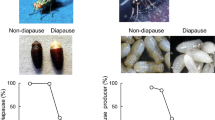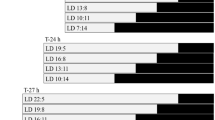Abstract
A wide diversity of organisms use photoperiod (daylength) as an environmental cue to anticipate the changing seasons and to time various life-history events such as dormancy and migration. Photoperiodic time measurement consists of two main components, (1) the photoperiodic timer that discriminates between long and short days, and (2) the photoperiodic counter that accumulates and stores information from the timer and then induces the phenotypic output. Herein, we use extended night treatments to show that light is necessary to accumulate photoperiodic information across the geographic range of the mosquito, Wyeomyia smithii and that the photoperiodic counter counts extrinsic (external) light:dark cycles and not endogenous (internal) circadian cycles.

Similar content being viewed by others
Abbreviations
- LDC50 :
-
Number of light:dark cycles necessary to elicit 50% development
- L:D:
-
Light:dark
References
Anonymous (1960) Biological clocks. The Biological Laboratory, Cold Spring Harbor, NY
Aschoff J (1965) Circadian clocks. North-Holland Publishing, Amsterdam
Bradshaw WE, Holzapfel CM (2007) Evolution of animal photoperiodism. Annu Rev Ecol Evol Syst 38:1–25
Bradshaw WE, Holzapfel CM, Mathias D (2006) Circadian rhythmicity and photoperiodism in the pitcher-plant mosquito: can the seasonal timer evolve independently of the circadian clock? Am Nat 167:601–605
Bradshaw WE, Lounibos LP (1972) Photoperiodic control of development in the pitcher-plant mosquito, Wyeomyia smithii. Can J Zool 50:713–719
Bradshaw WE, Lounibos LP (1977) Evolution of dormancy and its photoperiodic control in pitcher-plant mosquitoes. Evolution 31:546–567
Bradshaw WE, Quebodeaux MC, Holzapfel CM (2003a) Circadian rhythmicity and photoperiodism in the pitcher-plant mosquito: adaptive response to the photic environment or correlated response to the seasonal environment? Am Nat 161:735–748
Bradshaw WE, Quebodeaux MC, Holzapfel CM (2003b) The contribution of an hourglass timer to the evolution of photoperiodic response in the pitcher-plant mosquito, Wyeomyia smithii. Evolution 57:2342–2349
Bünning E (1936) Die endogene Tagesrhythmik als Grundlage der photoperiodischen Reaktion. Ber Dtsch Bot Ges 54:590–607
Bünning E (1964) The physiological clock. Springer, Berlin
Campbell MD, Bradshaw WE (1992) Genetic coordination of diapause in the pitcher-plant mosquito, Wyeomyia smithii (Diptera, Culicidae). Ann Entomol Soc Am 85:445–451
Danilevsky AS, Goryshin NI, Tyschenko VP (1970) Biological rhythms in terrestrial arthropods. Annu Rev Entomol 15:201–244
Danks HV (1987) Insect dormancy: an ecological perspective. Biological Survey of Canada (Terrestrial Arthropods), Ottawa
Hartl DL, Clark AG (1989) Principles of population genetics. Sinauer Associates, Sunderland
Lees AD (1973) Photoperiodic time measurement in the aphid Megorua vicicae. J Insect Physiol 47:821–832
Menaker M (1971) Biochronometry. National Academy of Sciences, Washington
Pittendrigh CS (1972) Circadian surfaces and diversity of possible roles of circadian organization in photoperiodic induction. Proc Natl Acad Sci USA 69:2734–2737
Pittendrigh CS, Minis DH (1964) The entrainment of circadian oscillations by light and their role as photoperiodic clocks. Am Nat 98:261–294
R Development Core Team (2007) R: a language and environment for statistical computing. R Foundation for Statistical Computing, Vienna
Ritz C, Streibig JC (2005) Bioassay analysis using R. J Stat Softw 12:1–22
Saunders DS (1978) Internal and external coincidence and the apparent diversity of photoperiodic clocks in insects. J Comp Physiol 127:197–207
Saunders DS (2002) Insect clocks. Elsevier Science, Amsterdam
Taylor F, Spalding JB (1986) Goegraphical patters in the photoperiodic induction of hibernal diapause. In: Taylor F, Karban R (eds) The evolution of insect life cycles. Springer, Berlin
vaz Nunes M, Saunders D (1999) Photoperiodic time measurement in insects: a review of clock models. J Biol Rhythms 14:84–104
Veerman A (2001) Photoperiodic time measurement in insects and mites: a critical evaluation of the oscillator-clock hypothesis. J Insect Physiol 47:1097–1109
Veerman A, vaz Nunes M (1987) Analysis of the operation of the photoperiodic counter provides evidence for hourglass time measurement in the spider mite Tetranychus urticae. J Comp Physiol A Sens Neural Behav Physiol 160:421–430
Veerman A, Veenendaal RL (2003) Experimental evidence for a non-clock role of the circadian system in spider mite photoperiodism. J Insect Physiol 49:727–732
Withrow RB (1959) Photoperiodism and related phenomena in plants and animals. American Association for the Advancement of Science, Washington
Acknowledgments
We would like to thank N. Bowen for her hours, odd and numerous, assisting with this project, S. Carroll and two anonymous reviewers for insightful comments on early versions of the manuscript. All work presented here complied with the “Principles of animal care,” publication No. 86-23 of the National Institute of Health, and also with current laws of the United States, where these experiment were performed. This work was made possible by generous support from the National Science Foundation through grants DEB-0412573 and IOB-0445710 to WEB, and the National Science Foundation and National Institutes of Health through training grants DGE-0504727 and 5-T32-GMO7413, respectively, to KJE.
Author information
Authors and Affiliations
Corresponding author
Rights and permissions
About this article
Cite this article
Emerson, K.J., Letaw, A.D., Bradshaw, W.E. et al. Extrinsic light:dark cycles, rather than endogenous circadian cycles, affect the photoperiodic counter in the pitcher-plant mosquito, Wyeomyia smithii . J Comp Physiol A 194, 611–615 (2008). https://doi.org/10.1007/s00359-008-0334-2
Received:
Revised:
Accepted:
Published:
Issue Date:
DOI: https://doi.org/10.1007/s00359-008-0334-2




